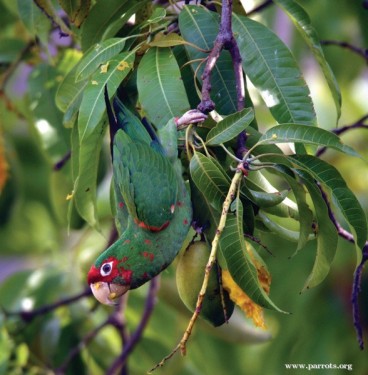
Mitred Parakeet
[order] PSITTACIFORMES | [family] Psittacidae | [latin] Aratinga mitrata | [authority] Tschudi, 1844 | [UK] Mitred Parakeet | [FR] Conure mitree | [DE] Rotmasken-Sittich | [ES] Buhito Menor (HN) | [NL] Roodmaskeraratinga | [copyright picture] Bill King
Monotypic species
Genus
The parrot genus Aratinga comprises 24 species. Aratinga is a genus of American parakeets. They belong to the long-tailed group. Most are predominantly green, although a few are predominantly yellow or orange. They are social and commonly seen in groups in the wild. In Brazil the popular name of several species usually is Jandaia, sometimes written as Jandaya in the scientific form.
The genus Aratinga includes species with habitat from South America to Mexico. Birds in the Aratinga genus have a “swift, direct flight” that differs from other similar birds according to “Parrots of the World.” Other characteristics include the males and females looking alike, a fully feathered face and a rather long tail that starts wide at the base and becomes slender at the tip.
A.m. mitrata: both adults green in colour, with yellow on the underparts; brown/red forehead turning to brighter red on forecrown, lores, cheeks and sides of neck; ear coverts occasionally red; red feathers scattered variably on hindneck, mantle, throat, thighs and bend of wing; olive/green underwing coverts. Bill horn colour. Eye ring bare and buff/white. Eye dull yellow with grey inner ring. A.m. alticola: both adults darker green than mitrata, particularly upperparts; red confined to thin frontal band and few scattered feathers on lores and sides of head; red on thighs absent.
Listen to the sound of Mitred Parakeet
[audio:http://www.planetofbirds.com/MASTER/PSITTACIFORMES/Psittacidae/sounds/Mitred Parakeet.mp3]
Copyright remark: Most sounds derived from xeno-canto
recorded by Sjoerd Mayer
| wingspan min.: |
0 |
cm |
wingspan max.: |
0 |
cm |
| size min.: |
31 |
cm |
size max.: |
38 |
cm |
| incubation min.: |
0 |
days |
incubation max.: |
0 |
days |
| fledging min.: |
0 |
days |
fledging max.: |
0 |
days |
| broods: |
1 |
|
eggs min.: |
2 |
|
| |
|
|
eggs max.: |
3 |
|
South America : Central Peru to Northwest Argentina. The Mitred Parakeet is a widespread and familiar parakeet of the central Andes, where it is common and widespread from central Peru south to northwestern Argentina; there also is a population, perhaps isolated, in northern Peru
In the northern portion of its range, this species primarily occurs at the borders of humid montane forest, and in the more humid portions of intermontane valley; in these regions it is replaced in drier mountain valleys by the Scarlet-fronted Parakeet (Aratinga wagleri). Farther south, where the Scarlet-fronted Parakeet does not occur, the Mitred Parakeet is more widespread in these drier montane forests. Seen generally in dry subtropical zones but also recorded from temperate areas such as montane deciduous forest, cloud-forest, cultivated fields, grassy hills with tall herbaceous plants, brush and scrub areas with scattered trees and legume-rich savanna.
Nests in tree hollows or even cliffs. Clutch size 2-3 eggs.
No details but berries and maize reported.
httpv://www.youtube.com/watch?v=zBjblpx_wa4
copyright: Josep del Hoyo
This species has a very large range, and hence does not approach the thresholds for Vulnerable under the range size criterion (Extent of Occurrence <20,000 km2 combined with a declining or fluctuating range size, habitat extent/quality, or population size and a small number of locations or severe fragmentation). The population trend appears to be stable, and hence the species does not approach the thresholds for Vulnerable under the population trend criterion (>30% decline over ten years or three generations). The population size has not been quantified, but it is not believed to approach the thresholds for Vulnerable under the population size criterion (<10,000 mature individuals with a continuing decline estimated to be >10% in ten years or three generations, or with a specified population structure). For these reasons the species is evaluated as Least Concern.
Probably somewhat nomadic in the post-breeding season. Has been reported amongst flocks of migrating species.



